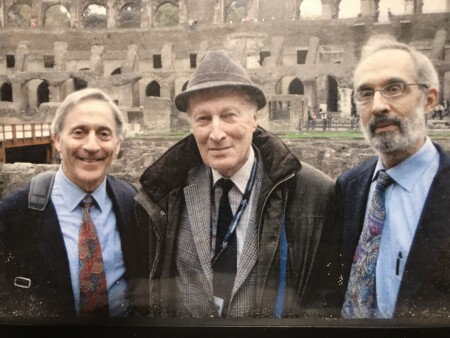Posted on August 22, 2021
Written by Barry Castleman, ScD, Environmental Consultant
Dr. Morris Greenberg died peacefully on August 19, 2021. As UK Medical Inspector of Factories, he published a report of cases in the UK Mesothelioma Registry in 1974. In addition to cases with occupational asbestos exposure as short as 3 weeks, one case included was a man whose only identified exposure was spending just one day sawing up asbestos sheets to make a chicken coop.
In his work at the UK Factory Inspectorate, in publications continuing throughout his retirement, and in his willingness to be an activist and work with others for a world free of asbestos use, Morris Greenberg was an exemplar. He wrote many papers analyzing historical events and showing where the authorities and industry had failed to protect the workers. https://pubmed.ncbi.nlm.nih.gov/?term=Greenberg%20M&cauthor_id=28913871&page=2
In one paper, he recalled that London dock workers concerned about handling jute sacks of asbestos sought out the advice of renowned occupational health physician Donald Hunter in 1965. Though Hunter supported their concerns, they were later lulled by reassurances from the port doctor and then trade union doctor Robert Murray (who would later go on to bankrupt asbestos activist Alan Dalton with a libel suit and testify in defense of T&N against asbestos victims). Greenberg went on to show that the reassurances were not evidence-based and that existing data at the time and in decades since have shown that dockers were at increased risk of cancer.
In 1997, the WHO Regional Office for Europe circulated draft reports “Asbestos and Health” and “Asbestos in Buildings.” Dr. Richard Lemen, retired chief of the US National Institute of Occupational Health, raised concern that the reports were misleading and read like endorsements for using asbestos. As controversy grew, WHO turned to Morris Greenberg to advise on the matter. Though the “Asbestos and Health” report was modified by its author, Greenberg slammed the revision as containing elements unfitting in a WHO report. Further criticism by union leaders and scientists including former IARC Director Lorenzo Tomatis led WHO headquarters to halt the report’s distribution in 1999. A second edition of the report, much improved by the adoption of language from previous international reports, was published in 2000. The “Asbestos in Buildings” report, whose atrocious draft advised local authorities to “de-dramatize the problem,” was never issued by WHO.
In 2008, the Collegium Ramazzini had just met in Carpi, Italy, and the periodic review of the Rotterdam Convention was scheduled to take place immediately afterward at the FAO in Rome. Activists were coming to contest the opposition (by countries including Canada) to including chrysotile asbestos in the PIC list of substances covered by the convention’s “prior informed consent” duty. Scientists were needed to join the activists in trying to make a difference, where over 100 countries were represented. Morris Greenberg and Colin Soskolne agreed to come down with me on the train and spend several days in Rome, in case anybody wanted to argue about the epidemiology of chrysotile asbestos. At one point, we joined a protest, holding large photographs of asbestos factory pollution in Asia. [Pictures attached]
Morris Greenberg was a kind and decent man as well as a distinguished public health worker.
A Fellow of the Collegium Ramazzini practically since its founding in 1982 by Dr. Irving Selikoff and Cesare Maltoni, Dr. Greenberg was remembered with great affection by his colleagues and activists. “A dear colleague and consummate gentleman” (Dr. Arthur Frank). “Wise, deeply committed, and very dedicated.” (Dr. Phil Landrigan, former President of the Collegium) “What a gentleman and scholar. His cryptic sense of humor and his advocacy for worker health and safety were from his heart. His contributions were many.” (Dr. Richard Lemen) “I remember his brilliant and biting wit, his scholarship and his human kindness. There won’t be another like him. Grace, scholarship and humanity don’t come along very often.” (Dr. Daniel Teitelbaum) “A real mensch.” (Dr. David Egilman)
Asbestos activists reacted with deep sadness to the passing of Morris Greenberg. “He was such a wonderful man.” (Laurie Kazan-Allen, IBAS) “His great contributions to public health and to end the man-made asbestos disaster will be remembered forever.” (Linda Reinstein, ADAO) “His work was dedicated to occupational justice across the globe which is an inspiration for countries like India where environmental-occupational health doctors are rare to find and required infrastructure is almost non-existent.” (Gopal Krishna, BANI)
Morris Greenberg was also a great help to US lawyers representing asbestos victims, in their efforts to excavate the public health and corporate history of asbestos. Gary Dimuzio wrote: “Morris, gentle giant of public and occupational health was unquestionably one of the major figures in occupational health including asbestos since the 1960s, he always fought for the ‘little guy’ even at the potential expense of his own career. We all use his articles. Despite advancing age and a fairly serious stroke several years ago, Morris was always willing to provide insights or help find an article or document that only he could find, as recently as just a few weeks ago. He will be missed.”
Longtime US plaintiffs’ lawyer Conard Metcalf reacted, “ A great loss. An incredible and enduring and powerful voice for workers and their families and of course for the science.”

